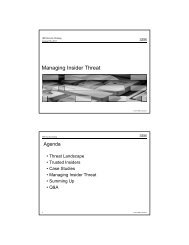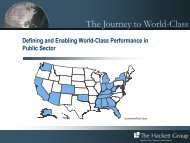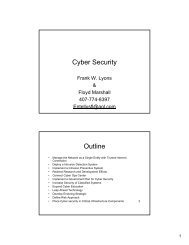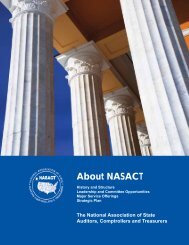Advisory Committee on Tax Exempt and Government Entities (ACT ...
Advisory Committee on Tax Exempt and Government Entities (ACT ...
Advisory Committee on Tax Exempt and Government Entities (ACT ...
You also want an ePaper? Increase the reach of your titles
YUMPU automatically turns print PDFs into web optimized ePapers that Google loves.
The Appropriate Role Of The Internal Revenue Service With Respect To <strong>Tax</strong>-<strong>Exempt</strong> Organizati<strong>on</strong> Good Governance IssuesThere are, however, occasi<strong>on</strong>al cases that are public. The required public release ofthe Hermann Hospital closing agreement, discussed in Appendix 3, is <strong>on</strong>e example.Perhaps the best-known instance of the IRS requiring governance changes as ac<strong>on</strong>diti<strong>on</strong> of c<strong>on</strong>tinued exempti<strong>on</strong> is the Kamehameha Schools / Bishop Estate matter,as described in the book Broken Trust. 127 In that matter, which has come to be knownas the Bishop Estate, the IRS required the wholesale removal of a charity’s governingbody as a c<strong>on</strong>diti<strong>on</strong> of not revoking the charity’s tax-exempt status. 128 The closingagreement between the Bishop Estate <strong>and</strong> the IRS required the charity to agree toadopt <strong>and</strong> implement a number of significant governance changes, in additi<strong>on</strong> to theremoval of the then current trustees. 129As with determinati<strong>on</strong>s, there also are occasi<strong>on</strong>al private letter rulings <strong>and</strong> technicaladvice memor<strong>and</strong>a 130 where the IRS determined that an organizati<strong>on</strong> did not qualify fortax exempti<strong>on</strong> under secti<strong>on</strong> 501(c)(3), at least in part because its governance structureresulted in private inurement or private benefit. In a technical advice memor<strong>and</strong>umreleased in 2004, the IRS looked at whether a closely-c<strong>on</strong>trolled church organizati<strong>on</strong>had violated the c<strong>on</strong>diti<strong>on</strong>s of tax-exempt status <strong>on</strong> various grounds. In analyzingwhether a substantial n<strong>on</strong>-exempt purpose existed, the IRS focused <strong>on</strong> theorganizati<strong>on</strong>’s accumulati<strong>on</strong> of substantial investment <strong>and</strong> commercial assets. The IRSc<strong>on</strong>cluded that the asset accumulati<strong>on</strong> was appropriate given the organizati<strong>on</strong>’sreas<strong>on</strong>able anticipated needs for financial reserves. In c<strong>on</strong>firming that the organizati<strong>on</strong>did not have a substantial n<strong>on</strong>-exempt purpose, the IRS commented:Small, closely-c<strong>on</strong>trolled exempt organizati<strong>on</strong>s—<strong>and</strong> especially those thatare closely c<strong>on</strong>trolled by members of <strong>on</strong>e family—with related businessentities require thorough examinati<strong>on</strong> to insure that the arrangementsserve charitable purposes rather than private interests. Qualifying forexempti<strong>on</strong> is a facts <strong>and</strong> circumstances test. There is nothing thatprecludes an organizati<strong>on</strong> that is closely c<strong>on</strong>trolled or has related for-profitorganizati<strong>on</strong>s from qualifying, or c<strong>on</strong>tinuing to qualify, for exempti<strong>on</strong>.However, the lack of instituti<strong>on</strong>al protecti<strong>on</strong>s, that is, a board of directorscomposed of active, disinterested pers<strong>on</strong>s, <strong>and</strong> the potential for suchorganizati<strong>on</strong>s to be abused requires IRS to closely examine actual127Samuel P. King & R<strong>and</strong>all W. Roth, Broken Trust: Greed, Mismanagement <strong>and</strong> Political Manipulati<strong>on</strong> at America’s LargestCharitable Trust (2006). All facts in this discussi<strong>on</strong> of the Bishop Estate are taken from Broken Trust <strong>and</strong> from the B. P. BishopEstate, Closing Agreement, August 18, 1999.128But see reservati<strong>on</strong>s expressed in Evelyn Brody, “A <strong>Tax</strong>ing Time for the Bishop Estate: What Is the I.R.S. Role in CharityGovernance?,” 21 U. Haw. L. Rev. 537, 545-46 (1999), reprinted at 29 <strong>Exempt</strong> Org. <strong>Tax</strong> Rev. 397 (2000).129These included: a new trustee selecti<strong>on</strong> process that included an independent appointment committee; a new managementstructure making clear that the trustees are resp<strong>on</strong>sible for establishing policy, not for managing the charity’s day-to-day operati<strong>on</strong>s,<strong>and</strong> assigning resp<strong>on</strong>sibility for those operati<strong>on</strong>s to a new Chief Executive Officer positi<strong>on</strong> who would review <strong>and</strong> supervise otherexecutives; any changes in this structure during the five years immediately following the executi<strong>on</strong> of the closing agreement requirednotice to the IRS; a system of checks <strong>and</strong> balances <strong>on</strong> the powers of the trustees <strong>and</strong> senior executives, including the newly createdCEO positi<strong>on</strong>; a c<strong>on</strong>flict of interest policy; a compensati<strong>on</strong> review process for the trustees <strong>and</strong> for senior executives; an annualfinancial statement audit, with the statements being made publicly available <strong>on</strong> the charity’s website <strong>and</strong> <strong>on</strong> request; <strong>and</strong> reimplementingan internal audit functi<strong>on</strong> with certain protecti<strong>on</strong>s designed to secure the independence of the internal auditor.130See supra note 116.ADVISORY COMMITTEE ON TAX EXEMPT AND GOVERNMENT ENTITIES (<strong>ACT</strong>) June 11, 2008 40













